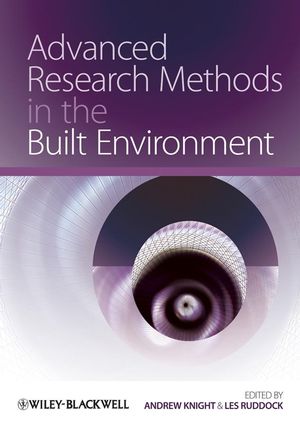Advanced Research Methods in the Built EnvironmentISBN: 978-1-4051-6110-7
Paperback
256 pages
October 2008, Wiley-Blackwell
 This is a Print-on-Demand title. It will be printed specifically to fill your order. Please allow an additional 10-15 days delivery time. The book is not returnable.
|
||||||
Foreword xi
Introduction xiii
Contributors xix
1 Methodological Pluralism in Construction Management Research 1
Andrew Dainty
Introduction 1
Research strategy and design 3
The dominant research paradigm within construction management 4
Discussion: The implications of methodological uniformity 6
The case for methodological pluralism in construction management research 8
Challenges in undertaking multi-paradigm research 9
Conclusions 10
Acknowledgements 11
Note 11
References 12
2 Architectural Research 14
Alan Penn
Introduction 14
A sketch of architectural design 15
The structure of architectural research 17
Space syntax and the social logic of space 18
Conclusion 25
Note 27
References 27
3 Legal Research 28
Paul Chynoweth
Introduction 28
The epistemology of legal scholarship 28
In search of a methodology 31
The cultural dimension 35
Conclusion 37
References 37
4 Feminist Research 39
Pat Morton and Sara Wilkinson
Introduction 39
What is feminist research? 39
Locating feminism in the social sciences 40
Locating the feminist researcher 42
Ethical considerations 43
Standpoint epistemologies 44
Participatory action research 45
Oral histories and diaries and women’s voices 45
Can anyone be a feminist researcher? 46
Conclusions 48
References 48
5 Approaches to Economic Modelling and Analysis 51
Les Ruddock
Introduction 51
General economic models 51
Relationships between economic variables – econometrics 52
Approaches and applications in the construction sector 56
Conclusions 61
References 62
6 Epistemology 64
Andrew Knight and Neil Turnbull
Introduction 64
Concepts 65
Classical epistemology 66
Modern epistemology 68
Postmodernism and the critique of epistemology 71
Conclusion 72
References 74
7 Scientific Theories 75
Göran Runeson and Martin Skitmore
Introduction 75
The philosophy behind theories 75
Scientific theories 76
Working as a scientist 77
The plot gets complex 78
Testing social science theories 79
A solution (or two) 83
Building new theories 83
Conclusions 84
References 84
8 Grounded Theory 86
Kirsty Hunter and John Kelly
Introduction 86
What is grounded theory? 86
Substantive to formal theory 87
Data collection and analysis 89
The theory building procedure 90
Data sorting 91
Coding and comparison groups 91
Theory development in case studies 93
Grounded theory challenges 93
Scope and limitations of theory 94
A good theory 95
The derived theory 96
Summary 96
References 97
9 Case Study Research 99
David Proverbs and Rod Gameson
Introduction 99
Case study research: An overview 99
Designing case studies 100
Identifying and selecting the case(s) 101
Collecting the information 101
Analysing the information 103
Writing up 104
Example 104
Conclusions 108
Acknowledgement 109
Notes 110
References 110
10 Interviews: A Negotiated Partnership 111
Richard Haigh
Introduction 111
The interview method 112
Interviews in the built environment disciplines 115
Planning, conducting and analysing interviews 116
Conclusion 120
References 120
Further reading 120
11 Questionnaire Design and Factor Analysis 122
Mike Hoxley
Introduction 122
Construction 123
Attitude scales 124
Piloting 125
Sampling 125
Administration 126
Coding 127
Software packages 127
Coding missing values 127
Data entry 128
Factor analysis 128
Summary 133
References 134
12 Using Software to Analyse Qualitative Data 135
Andrew King
Introduction 135
Why use software? 136
Comparison of software 136
Methodology and software 137
Analytic distance 139
Learning to use CAQDAS 139
The quality of qualitative research 140
Conclusion 141
References 141
13 Getting Started in Quantitative Analysis 144
Chris Leishman
Introduction 144
The essence of sampling theory 145
Other common forms of hypothesis test 147
Inference and causality – basic regression models 148
Multiple regression models 150
Concluding remarks 153
References 154
14 Artificial Neural Network Modelling Techniques for Applied Civil and Construction Engineering Research 155
Abdelhalim Boussabaine and Richard Kirkham
Introduction 155
First concepts 155
System dynamics 157
Network structure and nomenclature 158
System architecture design 160
Recent advances in construction and civil engineering research 166
Neuro-fuzzy modelling 167
Conclusion: Why neuro-fuzzy models? 167
References 169
15 Social Network Analysis 171
Stephen Pryke
Introduction 171
Why choose social network analysis? 172
Concepts and terminology 173
Finally on SNA theory and techniques 178
Software for the analysis of networks 178
Conclusion 180
References 181
16 Managing the Thesis 183
Alan Griffith and Paul Watson
Introduction 183
Defining the thesis 183
Having a clear research focus 184
Developing and managing the draft thesis 185
Producing the final version of the thesis 188
Knowing the thesis and preparing for the viva voce 189
Conclusions 192
References 192
Further reading 192
17 Getting Your Research Published in Refereed Journals 193
Will Hughes
Introduction 193
Writing good journal papers 193
Elements of a journal submission 198
Editorial processes 202
Publication and dissemination 205
Conclusion 205
Note 206
References 206
18 Researcher Attitudes and Motivation 207
David Boyd
Introduction 207
Inner self 207
Personal environment 211
The research project 212
Research environment 213
Conclusion: Keeping going and succeeding 214
References 215
19 Built Environment Futures Research: The Need for Foresight and Scenario Learning 216
John Ratcliffe
Introduction 216
Concept and context 216
Conclusion 226
References 227
Index 229



